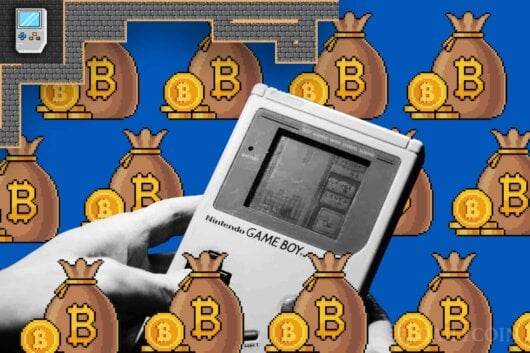How Long Does It Take to Mine a Bitcoin on Game Boy? A Million Times Faster Than with Pencil and Paper

More than 90% of possible Bitcoin circulation is already mined. This makes Bitcoin mining difficulty extremely high. Nowadays, the average cost to mine one Bitcoin is $12,000. The public miners use stacks of expensive Nvidia RTX 3090 GPUs. However, it doesn’t mean you cannot mine Bitcoin on less powerful devices, like a Game Boy.
It just takes longer.
How Long Does It Take to Mine One Bitcoin on Game Boy?
A year ago, YouTuber Thomas ‘stacksmashing’ Roth published a video in which he made the original Game Boy mine Bitcoin. The console had only a single-core 4.19 MHz processor and 8 Kbytes of RAM on the board. In comparison, some modern GPUs have 1.7 GHz of clock speed and 16-24 GB of memory.
In order to make Game Boy connect with the Bitcoin network, he modified its original Link Cable, which allowed it to connect two Game Boys and share Pokémons, and linked it to pocket computer Raspberry Pi Pico. In this “rig,” the Raspberry part runs a Bitcoin node, while Game Boy runs a hashing program uploaded on a flash cartridge, which is inserted in Game Boy as a regular game cartridge. Of course, the software was written by Tom himself. He even added small animation of the Bitcoin logo sliding from left to right.
So What’s the Mining Speed of Such a “Rig”?
According to Tom, a Game Boy is able to calculate 0.8 hashes per second. In comparison, a modern miner works at 100 terahashes per second, which is 120 trillion times faster. Moreover, the Bitcoin mining difficulty has risen 33% since then.
This means it would take a few quadrillion years to mine one Bitcoin on Game Boy!
However, it’s worth mentioning that Game Boy is absolutely able to handle mining a Bitcoin on a custom empty Bitcoin network. This means Nintendo’s console was suitable for mining the very first Bitcoins even though it was released 20 years before the creation of Bitcoin itself.
What Is the Slowest Way to Mine Bitcoin?
Another YouTuber, Ken Shirriff, went even further. What’ an even less powerful machine in comparison to Game Boy? Of course, he could use one of the first Pong home consoles, but it would be hard to make them communicate with a Bitcoin node, as they weren’t supposed to connect to anything else than your TV, so no magical link cables.
So he decided to use a pencil and paper to calculate a hash. Obviously, the first well-known calculator is a human brain! And every computer is just an extremely advanced calculator.
It turned out that Ken’s brain was able to “mine” one block round in 16 minutes and 45 seconds. With this speed, mining one Bitcoin block, which consists of 128 rounds, would take 1.49 days, which equals a hash rate of 0.67 hashes a day.
Now, let’s check the date of the video: September 28, 2014. Should I mention that the mining difficulty was close to zero in 2014? Of course, everything is possible in this world. The only question is “why?”
The funniest part of his research was calculations on energy consumption:
“...assuming a resting metabolic rate of 1500kcal/day, manual hashing works out to almost 10 megajoules/hash. A typical energy consumption for mining hardware is 1000 megahashes/joule. So I'm less energy efficient by a factor of 10^16, or 10 quadrillion,” Ken mentioned in his blog.
Further cost calculations came up even more ridiculous:
“A cheap source of food energy is donuts at $0.23 for 200 kcalories. Electricity here is $0.15/kilowatt-hour, which is cheaper by a factor of 6.7 - closer than I expected. Thus my energy cost per hash is about 67 quadrillion times that of mining hardware,” he continued.
Also, Ken didn’t include the cost of paper and pencils in his “data report.” And I guess he’ll need a lot of that. At least, now we see that our current mining procedure with rigs and GPUs is more sustainable than cutting trees, making paper, and using it for Bitcoin mining calculations.
Anyways, there is a lesson out of such a seemingly ridiculous experiment: sometimes people are more suitable for the creation of things rather than monotonous work!
To Sum Up
In this article, I wanted to show the mathematical magic behind every Bitcoin, and therefore cryptocurrency. People became too focused on price fluctuations, frauds, and other things, forgetting what’s under the hood.
Blockchain technology is one of the first perfectly working ways of value storage in the digital world. And even if it’s not perfect, it is a start for something more reliable and technically advanced.
Text source: DailyCoin.com










